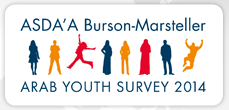
Event Review: Top 10 Findings of 2014 ASDA’A Arab Youth Survey
On June 10, American Security Project hosted Worldwide Executive Vice President of Burson-Marsteller and CEO of Penn Schoen Berland (PSB) Jay Leveton to discuss the findings of the 2014 ASDA’A Burson-Marsteller Arab Youth Survey. This marks the sixth installment of this annual report which polled 3,500 Arab youths aged 18-24 in the Middle East. The survey was conducted across 16 different countries in the region including UAE, Saudi Arabia, Qatar, Kuwait, Oman, Bahrain, Iraq, Egypt, Jordan, Lebanon, Libya, Tunisia, Morocco, Algeria, Yemen, and, for the first time in 2014, Palestine. Here are the top 10 findings:
1.) “Arab youth are embracing modernity and family, parents, friends, and religion remain their biggest influence”
Although traditional values still hold the greatest weight amongst Arab youth, modern ideals have experienced a drastic increase in influence, rising from 17% to 46% since 2011. The exact definition of “traditional” and “modern” values were left up to the respondent’s discretion, but follow-up questions indicated that family, friends, and religion comprised the traditional values that, while declining in favor of a balance with modern values, are still deeply rooted among the youths.
2.) “Youngsters are confident in their national governments but optimism experienced during the Arab Spring is waning”
Even throughout the government upheaval that has been seen in parts of the Middle East in recent years, the percentage of respondents who were “somewhat confident’” or “very confident” in their respective governments remains in the mid-60s. Despite a slight downturn since the Arab Spring, these confidence levels are still much higher than the global average among youths, according to Leveton.
3.) “Rising living costs and unemployment remain top concerns amongst Middle East youth”
Overall, the survey found that Arab youth were heavily focused on economic issues with rising living costs and unemployment at the height of their concerns. However, unlike many of the other findings of this survey in which trends were similar between all of the countries, concern over unemployment in particular was much lower among respondents in countries within the Gulf Cooperation Council (GCC) than in non-GCC countries. In fact, there was a gap of almost 20%.
4.) “Civil unrest is the biggest obstacle facing the region.”
After experiencing a 10% increase from 2013, 55% of Arab youths identify civil unrest as the biggest obstacle facing their country today, most likely as a result of what Leveton referred to as a “tumultuous year” for much of the region. Civil unrest far outweighed other responses. In fact, the second largest obstacle, which was “lack of democracy,” was identified by only 38% of respondents.
5.) “Entrepreneurial spirit is high and a growing number of young Arabs would like to work in the private sector”
Among GCC countries, the majority of Arab youth have traditionally identified a desire to work for the government over other sectors – a trend that is not shared by much of the rest of the world. However, this number has declined by over 20% since 2012 (from 64% to 43%). Interestingly, this decline has been accompanied by increasing desires to pursue entrepreneurship. It appears that as concerns about unemployment continue to grow, entrepreneurship is becoming increasingly appealing as a means to create job opportunities.
6.) “UAE continues to be seen as a model nation and scores higher in terms of favorability than the US, UK and France”
Arab youth view the United Arab Emirates (UAE) as a model for the rest of the Middle East to emulate, ranking it far above other Arab nations. Interestingly, the United States is second on this list.
7.) “Arab youth believe their country’s biggest allies are their regional neighbors”
Of these regional neighbors, Saudi Arabia and the UAE were the most favored.
8.) “Arab youth are more concerned about health issues but the majority do not feel that healthcare in their home country is improving”
Most notably, concern about obesity has increased from 12% to 26%. However, despite this recent surge in concern surrounding health issues, there remains a sizable portion of Arab youth that do not consider national health to be one of their country’s most pressing issues. Possibly due to this lack of widespread support, those who are concerned are not seeing improvements.
9.) “An overwhelming majority believe they are entitled to subsidized energy costs while concern about climate change is low”
Between 70-80% of Arab youths believe that they are entitled to subsidized energy costs. However, climate change was identified as the least concerning issue facing the region despite the fact that the Middle East is projected to be one of the most affected areas in the wake of global warming. Leveton posited that this massive misalignment from the global trend may be attributed to a lack of dialogue and education of the potential outcomes.
10.) “Television is king but more young Arabs are turning to online and social networks to get their news”
Sparked by the Arab Spring, daily consumption of news has almost tripled in the last four years, increasing from 18% to 45% among Arab youths. Not only has total consumption increased, but the way in which Arab youths are retrieving this information is also shifting and mirroring global trends. While traditional news sources such as the radio, newspapers, and magazines have experienced steep decline in both total viewership and consumer trust in reliability, online sources and social media have taken off.
For more information, check out the podcast:
Or video of the entire event:






[…] Event Review: Top 10 Findings of 2014 ASDA’A Arab Youth Survey […]